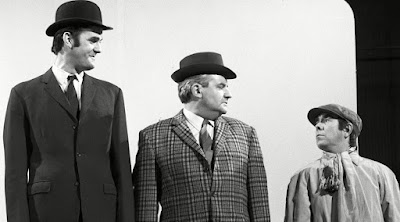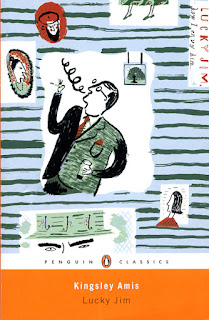In 1977, Eastern Europe was still in the grip of Communist regimes controlled by the Soviet Union. In Czechoslovakia, there had been a crackdown following the liberal period known as the Prague Spring, and subsequent Soviet invasion. the playwright Václav Havel had been imprisoned several times for opposing the Communist system. He became President after independence.
That autumn, I was in the middle of a few idle weeks between receiving the ‘A’ Level examination grades that had got me in to university as a mature student, working for the summer on night shifts in a canning factory, a walking holiday in Iceland, and starting my new course. One Wednesday evening, with nothing to do, I clicked through the three television channels we then had, wondering whether there was anything I might watch. I caught the beginning of a televised play which seemed to be about university lecturers. I quickly realised it was something special.
It was Tom Stoppard’s ‘Professional Foul’. It opens with a scene on an aeroplane in which a Cambridge Professor of Ethics, Professor Anderson, is on his way to a philosophical colloquium in Prague to give an invited talk. Another academic on the plane from a lesser, working-class university, McKendrick, forces him into conversation, but Anderson shows no interest in the colloquium, or anything philosophical at all. We later learn he has an ulterior motive for accepting the expenses-paid invitation, which is to go to a football match between England and Czechoslovakia, a World Cup qualifier.
In true Stoppard fashion, the plot becomes more and more complicated from then on, with interleaving themes and clever word play. The main themes are how ethical behaviour can be compromised by real-life events, and the oppression of individual expression by authoritarian regimes.
In Prague, Professor Anderson spots two English footballers at his hotel. He is also approached by a Czech ex-student, Holler, who despite getting a First, is only allowed in Czechoslovakia to work as a cleaner.
Holler asks Anderson to smuggle a thesis out of the country. This gives Anderson an ethical dilemma. The thesis concludes that the morality of the state should be derived from that of the individual, which is a position not permitted under a system that denies freedom of thought. Anderson, however, concludes that as a guest of the government, it would be unethical to take the thesis, but agrees to return it to Holler’s flat the next day, rather than risk him being caught in the street with dissident material.
He calls at Holler’s flat on the way to the football match, to find it being searched by police. They prevent him from leaving, but switch on the radio broadcasting the match. One of the footballers from the hotel commits a deliberate ‘professional foul’ to deny the opponents a scoring opportunity. The police also commit a professional foul of their own by planting foreign currency in the flat.
Anderson returns to the hotel exhausted, with the thesis still in his possession. Later, Mrs. Holler and their son arrive to ask for his help. They tell him that Holler was arrested on the way home from visiting him the previous evening. Disturbed by their plight he promises to do all he can. It makes him think further about his ethical dilemma over Holler’s thesis, and revise his position.
After dinner, McKendrick holds forth loudly to the other residents in the hotel lounge. He is clearly very drunk, and enamoured by his own linguistic dexterity. He lectures them about the ethics of professional fouls by working-class footballers. One of the footballers thumps him to the ground. Anderson helps him back to his room and leaves him to sleep it off.
In light of what he has seen, Anderson re-writes his talk to discuss the conflict between the rights of individuals and the rights of the state, including freedom from search and interference, and whether it is ethical to put someone in prison for reading or writing the wrong books. The worried chairman cuts his talk short by arranging a fire alarm. Two more professional fouls.
At the airport on the way home, Anderson’s luggage is carefully searched while McKendrick is allowed straight through. Another academic is detained for carrying letters to Amnesty International. On the plane, McKendrick and Anderson discuss this, and Anderson mentions the thesis. McKendrick asks where he hid it, and Anderson reveals he took advantage of McKendrick’s unconsciousness to hide it in his brief case. Another professional foul. McKendrick is furious, which Anderson understands, but concludes that his unethical actions were justifiable in the real-life circumstances. He surmises that ethical philosophy can be very complicated.
Although the play conveys a menacing sense of state repression, it is entertaining, clever and funny. The quick-witted Anderson character is delightful. It is set in very different times to now, in a country where those who held the wrong opinions suffered discrimination. It could easily return, either there or here.
This misses an awful lot out, but the plot is much easier to summarise than the philosophy. I did not understand the half of it, but it brought home the fun in playing creatively with ideas, and that it might be part of university life. If my course encouraged just a small amount of this, I was going to enjoy it.
The play is on YouTube (here). I still don’t get all the philosophical references, though.
































